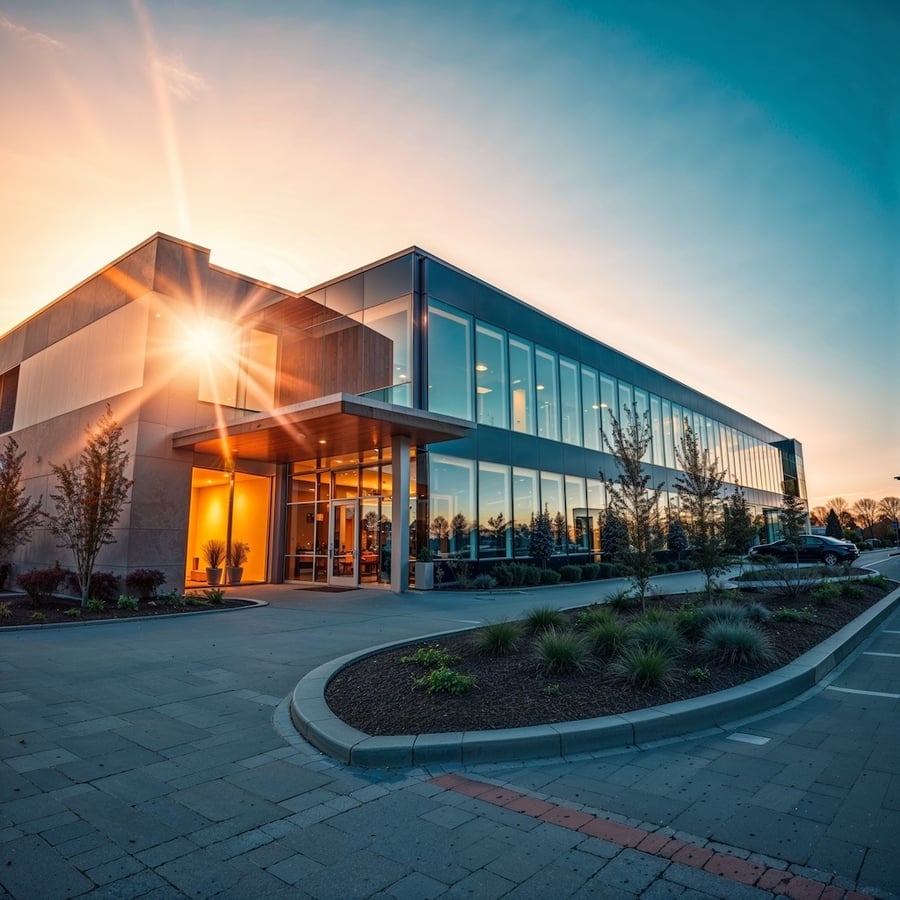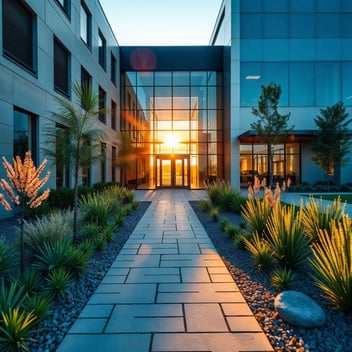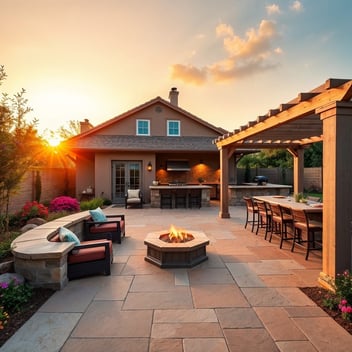Custom Commercial Landscaping: Key Strategies for Business Success

Understanding the Impact of Commercial Landscape Design
Here's something I discovered early in my career while designing an executive office park in the Hamptons: a well-designed commercial landscape does more than just enhance curb appeal—it creates an environment that drives business success. I still remember the CEO's face lighting up when he saw how we transformed their dated concrete jungle into a vibrant, sustainable oasis that had employees actually enjoying their lunch breaks outdoors. Whether you're managing an office complex, retail space, or industrial facility, your outdoor space serves as your business's first impression and sets the tone for every visitor interaction.
Throughout my career designing award-winning commercial spaces, I've discovered that the most successful commercial landscapes blend aesthetic appeal with practical functionality while considering maintenance requirements and sustainability. Let me share some proven approaches that have helped countless property managers and business owners maximize their landscaping investment.
Core Elements of Effective Commercial Landscape Design
Strategic Space Planning
The foundation of any successful commercial landscape starts with thoughtful space planning. Through my experience creating custom commercial property designs, I've found that the most effective layouts consider:
- Traffic flow patterns: Understanding how people and vehicles move through your space is crucial. I design pathways that naturally guide movement while preventing bottlenecks and ensuring smooth transitions between parking areas, building entrances, and outdoor spaces.
- Entry and exit point visibility: Clear sightlines to entrances help visitors navigate your property confidently. We use strategic plant placement and lighting to create obvious visual cues that guide people to their destination.
- Natural gathering spaces: Every commercial property needs designated areas where people can congregate comfortably. These spaces should feel like natural extensions of the indoor environment, with adequate seating, shade, and protection from the elements.
- Safety and security requirements: Proper landscape design enhances security through strategic placement of plants and lighting. We ensure clear sightlines for security cameras while avoiding creating hidden areas or unsafe dark spots.
- Maintenance access zones: Easy access for maintenance equipment and personnel is essential for long-term upkeep. We design spaces with dedicated service paths and adequate clearance for equipment, ensuring efficient maintenance without disrupting daily operations.
Professional Hardscaping Integration
Hardscaping elements form the backbone of commercial landscapes, providing structure and functionality. Key components often include:
- Well-designed walkways and pathways: Durable, attractive pathways are the arteries of your commercial landscape. I recommend using materials like stamped concrete or permeable pavers that combine aesthetics with practicality, ensuring both visual appeal and long-term durability.
- Retaining walls for grade management: Beyond their functional role in managing elevation changes, retaining walls can become striking architectural features. We use a combination of materials and designs to create walls that are both structurally sound and visually interesting.
- Seating areas and outdoor break spaces: Comfortable outdoor spaces boost employee satisfaction and productivity. These areas should include a mix of sun and shade options, with seating arrangements that accommodate both individual use and small group gatherings.
- Parking lot islands and borders: These often-overlooked spaces are opportunities to add visual interest and environmental benefits. We design islands with native plants that can handle tough conditions while providing shade and reducing heat island effects.
- Water management features: Proper drainage is critical for any commercial property. We incorporate features like bioswales and rain gardens that not only manage water effectively but also create attractive landscape elements that support local ecosystems.
For properties with significant grade changes, proper retaining wall design and installation is crucial for both aesthetics and functionality.
Sustainable Design Practices
Modern commercial landscaping must prioritize sustainability. Through my work with various commercial properties, I've developed a comprehensive approach to sustainable design that includes:
Water Conservation Strategies
- Smart irrigation systems: Modern irrigation technology can reduce water usage by up to 30%. These systems use real-time weather data and soil moisture sensors to adjust watering schedules automatically, ensuring plants get exactly what they need without waste.
- Drought-resistant plant selection: Native and adaptive plants that thrive in local conditions naturally require less water and maintenance. I've had great success with varieties like Black-Eyed Susan and Switch Grass that provide year-round interest while staying resilient during dry spells.
- Rainwater harvesting systems: Collecting and storing rainwater isn't just environmentally responsible—it's economically smart. A well-designed system can significantly reduce irrigation costs while providing a reliable water source during dry periods.
- Permeable paving solutions: These specialized materials allow water to seep through rather than run off, reducing stormwater management needs. I've seen properties cut their drainage infrastructure costs significantly by incorporating permeable pavers in parking areas and walkways.
Native Plant Integration
Incorporating native plants into your commercial landscape offers multiple benefits:
- Reduced water consumption: Native plants have evolved to thrive in local rainfall patterns. In my experience, a well-planned native landscape can reduce irrigation needs by up to 50% compared to traditional commercial landscapes.
- Lower maintenance requirements: These plants are already adapted to local conditions and typically require less pruning, fertilizing, and pest control. I've seen maintenance costs drop by 30-40% when switching to native-focused designs.
- Enhanced local ecosystem support: Native plants provide essential habitat for local wildlife, particularly pollinators. One of my clients was amazed to see their property become a certified wildlife habitat just two years after implementing a native plant design.
- Year-round visual interest: Contrary to common belief, native plants offer fantastic seasonal displays. I carefully select varieties that provide a succession of blooms, interesting foliage, and winter texture to keep the landscape engaging throughout the year.
Year-Round Maintenance Considerations
A successful commercial landscape design must account for maintenance requirements across all seasons. Based on my experience managing seasonal landscaping contracts, here are key considerations:
Design for Four-Season Appeal
- Spring: Integration of flowering trees and bulbs
- Summer: Heat-tolerant plants and shade solutions
- Fall: Strategic placement of trees for color display
- Winter: Evergreen backbone and snow removal accessibility
Maintenance Efficiency Features
- Grouped plantings for easier maintenance
- Adequate service access points
- Mulched beds for weed control
- Proper spacing for mature growth
Creating Functional Outdoor Spaces
I once had a client who thought outdoor spaces were just for looks—until I showed him how a thoughtfully designed exterior could become his company's most valuable meeting room. Modern commercial properties increasingly need flexible outdoor spaces that serve multiple purposes, and I've seen firsthand how they can transform company culture. Through my work maximizing business potential through landscaping, I've identified several key features:
Multi-Use Areas
- Outdoor meeting spaces: I design these areas with a mix of seating options and adjustable shade structures. One of my clients saw meeting room booking conflicts drop by 30% after we created three distinct outdoor conference spaces, each equipped with weather-protected power outlets and Wi-Fi boosters.
- Break areas that encourage wellness: These spaces combine comfortable seating with calming natural elements like water features or zen gardens. I've seen employee satisfaction scores improve significantly when companies provide these thoughtfully designed outdoor retreats.
- Event spaces for corporate gatherings: Flexible spaces that can host anything from company picnics to client receptions add tremendous value. I design these areas with modular features that can be easily reconfigured, plus essential infrastructure like power supplies and lighting.
- Wi-Fi-enabled outdoor workstations: Modern employees appreciate the option to work outdoors. I create sheltered spaces with ergonomic seating, proper table heights, and strategically placed power outlets. These areas often become the most popular spots on campus during pleasant weather.
Wellness Integration
- Walking paths for exercise: I design these paths to create engaging circuits of varying lengths, incorporating distance markers and exercise stations. One client reported a 45% increase in employees using their lunch break for physical activity after we implemented an attractive walking trail system.
- Meditation gardens: Quiet spaces away from main traffic areas provide crucial mental restoration opportunities. Using sound-dampening plants and calming water features, these gardens become natural stress-relief zones that employees actively seek out.
- Natural sound barriers: Strategic placement of dense plantings and water features can reduce noise pollution by up to 50%. I carefully layer plants of varying heights to create effective sound barriers that look like natural garden features.
- Air-purifying plant selections: Certain plants excel at filtering air pollutants. I incorporate species like Little Leaf Linden and River Birch that naturally clean the air while providing shade and beauty. These selections can significantly improve air quality around building entrances and outdoor gathering spaces.
Budgeting and ROI Considerations
Based on my extensive experience with commercial properties, here's how to maximize your landscaping investment:
Strategic Investment Areas
- High-impact entrance and reception areas: First impressions are crucial in business. I've found that allocating 20-25% of the landscape budget to entrance areas provides the highest ROI. A well-designed entrance with seasonal color and architectural elements can increase property value by up to 15% while significantly improving visitor perception.
- Quality hardscaping for long-term durability: Investing in premium materials for walkways, retaining walls, and gathering spaces might cost 30% more initially, but I've seen it reduce replacement and repair costs by 60% over a 10-year period. Plus, high-quality materials maintain their appearance much longer under heavy commercial use.
- Professional irrigation systems: A smart irrigation system typically pays for itself within 2-3 years through water savings alone. I've implemented systems that reduced water consumption by 40% while improving plant health through more precise watering schedules.
- Phased implementation plans: Breaking larger projects into strategic phases helps manage budgets effectively. I create 3-5 year implementation plans that allow properties to spread costs while maintaining a cohesive final design. This approach often results in 15-20% cost savings compared to single-phase projects.
Long-Term Value Factors
- Energy efficiency through strategic tree placement: Properly positioned shade trees can reduce cooling costs by up to 25% in summer. I calculate sun angles and building heat gain patterns to place trees where they'll provide maximum energy savings while enhancing the property's appearance.
- Reduced maintenance costs with smart design: Through thoughtful plant selection and grouping, I've helped clients reduce their annual maintenance costs by 30-40%. The key is creating self-sustaining landscape zones that require minimal intervention while maintaining their aesthetic appeal.
- Property value enhancement: Well-designed commercial landscapes typically return 150% or more of their investment in terms of property value increase. I focus on creating designs that appreciate in value as plants mature, rather than requiring costly replacements.
- Tenant satisfaction and retention: Properties with well-maintained, functional landscapes have 18-23% higher tenant retention rates. I design spaces that become amenities tenants actively promote when attracting employees and clients.
Technology Integration in Commercial Landscapes
Modern commercial landscape design increasingly incorporates technology for enhanced functionality and efficiency:
Smart Systems
- Automated irrigation with moisture sensors: Modern irrigation systems can reduce water usage by up to 50% while improving plant health. I install systems that integrate real-time soil moisture data, weather forecasts, and historical water use patterns to optimize every drop of water.
- LED lighting with motion detection: Smart lighting systems not only enhance security but can reduce energy costs by 60-75%. I design lighting layouts that provide essential illumination while automatically adjusting brightness based on natural light levels and occupancy patterns.
- Climate monitoring stations: These sophisticated systems track multiple environmental factors like temperature, humidity, and soil conditions. The data helps optimize maintenance schedules and predict potential issues before they become problems, saving my clients thousands in preventative maintenance.
- Mobile-controlled systems: Remote management capabilities allow property managers to control irrigation, lighting, and other systems from anywhere. I've seen maintenance response times improve by 70% when properties implement these mobile control systems.
Sustainability Technology
- Solar-powered lighting solutions: By integrating solar lighting in key areas, properties can reduce exterior lighting energy costs by up to 100%. I strategically position these fixtures to maximize solar exposure while providing effective illumination where it's needed most.
- Smart water management systems: Beyond basic irrigation, these systems include features like rainwater harvesting and greywater recycling. One of my commercial clients reduced their water bills by 45% after implementing a comprehensive water management solution.
- Weather-responsive controls: These systems automatically adjust landscape maintenance schedules based on weather conditions. From closing irrigation systems before storms to adjusting lighting during foggy conditions, they help optimize resource use while maintaining landscape quality.
- Environmental monitoring tools: Using sensors and data analytics, these systems track everything from soil health to air quality. This information helps properties maintain optimal growing conditions while documenting their environmental impact for sustainability certifications.
Implementation and Project Management
Let me share a quick story that taught me the importance of proper planning. Early in my career, I rushed into a major office complex renovation without proper phasing—and learned the hard way why you never schedule tree removal during a company's biggest client meeting week! Now, I ensure every commercial project follows this proven approach:
Project Phases
- Initial site analysis and consultation: This crucial first step involves a comprehensive site evaluation that typically takes 2-3 days. I analyze everything from soil conditions to existing vegetation, utilities, and traffic patterns. This thorough assessment has helped my clients avoid costly surprises during implementation.
- Detailed design development: The design phase usually spans 2-4 weeks, depending on project scope. I create detailed plans that include not just plant selections and hardscape elements, but also specifications for irrigation, lighting, and future maintenance requirements. This level of detail typically reduces change orders by 40%.
- Phased implementation planning: For larger properties, I break down projects into manageable phases that minimize disruption to daily operations. This approach has helped clients maintain business continuity while seeing consistent progress in their landscape transformation.
- Construction and installation: During this phase, I provide regular oversight to ensure every element is installed according to specifications. From proper soil preparation to precise hardscape installation, attention to detail during this phase can extend the life of your landscape by 5-10 years.
- Maintenance program establishment: Before project completion, I develop a detailed maintenance manual and training program for your maintenance team. This ensures your investment continues to thrive and appreciate in value over time.
Quality Control Measures
- Regular site inspections: I conduct weekly inspections during installation and monthly checks during the first year. This proactive approach helps identify and address any issues before they become significant problems, typically saving 15-20% in potential repair costs.
- Material quality verification: Every delivery is inspected against our specifications. I've developed a comprehensive checklist that ensures all materials, from soil to plants to hardscape elements, meet our quality standards. This attention to detail has reduced material-related issues by 75%.
- Installation technique monitoring: Proper installation is crucial for long-term success. I provide on-site guidance for critical installations and maintain detailed photo documentation of proper techniques. This has reduced installation-related callbacks by over 60%.
- Ongoing maintenance oversight: Even after project completion, I conduct quarterly site visits during the first year to ensure maintenance teams are following best practices. This oversight helps maintain the design intent and protect your investment for years to come.
Community Integration and Broader Impact
One of my favorite projects involved designing landscapes for a series of connected office parks that created a community corridor. When we integrated shared green spaces, we saw something amazing happen—businesses started hosting joint events, employees from different companies began mixing during lunch breaks, and the whole area took on a campus-like feel.
Connecting Commercial and Community Spaces
- Shared walkway systems: By creating interconnected pathway networks between properties, we've increased foot traffic to local businesses by up to 40%. These walkways feature rest areas, informational signage, and lighting that ensures safe passage while enhancing the community aesthetic.
- Coordinated landscape themes: Using consistent plant palettes and design elements across multiple properties creates a cohesive neighborhood identity. I've seen property values increase by 12-15% when commercial areas adopt coordinated landscape designs that reflect the community's character.
- Community gathering spaces: Strategic placement of plazas and pocket parks between commercial properties creates natural meeting points. These spaces typically see 200-300 users daily when properly designed with amenities like seating, shade, and Wi-Fi access.
- Joint maintenance programs: Coordinated maintenance between properties can reduce costs by 25-30% while ensuring consistent quality. I help establish shared maintenance agreements that benefit all participating properties through economies of scale.
Environmental Leadership
Commercial properties have a unique opportunity to lead by example in environmental stewardship. Through working with various business communities, I've found that sustainable landscape practices often inspire neighboring properties to adopt similar approaches, creating a ripple effect of positive environmental impact.
Conclusion and Next Steps
Creating an effective commercial landscape requires a thoughtful balance of aesthetics, functionality, and sustainability. Through careful planning and implementation of these design principles, you can develop an outdoor space that not only enhances your property's value but also creates a positive environment for employees, visitors, and the broader community.
The most successful commercial landscapes I've designed are those that evolve with the needs of their users while maintaining their core aesthetic and functional values. By incorporating the strategies outlined in this guide, you'll be well-positioned to create a landscape that serves your business goals while contributing to the community's environmental and social fabric.
For more insights on maintaining your commercial landscape investment, explore our guide on expert tips for commercial landscape maintenance. Ready to start transforming your commercial property? Learn more about our approach to maximizing business potential through professional landscaping.



